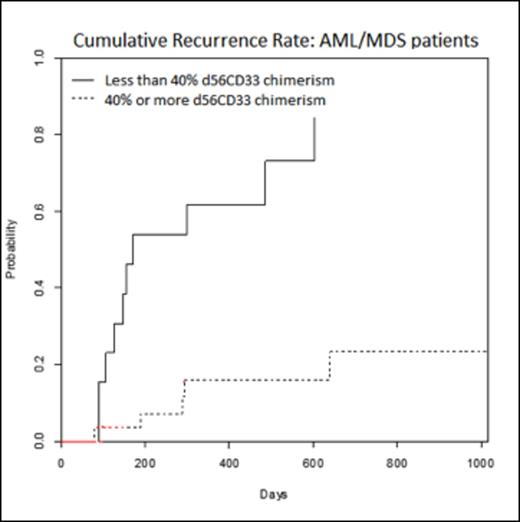Abstract
Haplo cord transplant combines an umbilical cord blood unit (CBU) graft with a CD34 selected adult haplo-identical graft for the purpose of establishing long term CBU chimerism, which occurs in most but not all cases. Previously we showed that excessive haplo CD34 doses impair CBU engraftment (Liu et al, Blood 2011). Since then we have utilized a fixed haplo CD34 dose of 5x106 CD34 cells/kg. We also conducted a prospective study of CBU threshold dose de-escalation and established a minimum CBU dose of 1.2 x106 TNC/kg as the threshold for further study (van Besien ASH 2014, 1093).
Here- using the patients from our prospective study- we sought to identify additional predictors of CBU engraftment as measured by percentage of CBU chimerism in CD33 and CD3 lineages in patients engrafted and in remission by day 56. We focused on d56 chimerism because durable patterns of chimerism are established by then.
83 pts were enrolled, but 23 were excluded from analysis because of early death (6) relapse before day 60 (8), failure of both grafts with residual MDS (4), lost to follow up (1) and no chimerism measurements (3).
61 pts were analyzed with median age 62 (18-72 years), 41 AML/MDS, 12 NHL, 5 ALL and 4 others. 24 had ASBMT high risk, 13 intermediate and 23 low risk disease. Conditioning was Flu Mel ATG (n=46), Flu Mel TBI 400 ATG (n=14) and Flu Mel TBI 600 ATG (n=1). All pts received GVHD prophylaxis with tacrolimus until d 180 and mycophenolate until d 30. The haplo dose was fixed at 5 x 106 CD34 cells/kg. Donors targeted by recipient donor specific antibodies (DSA) were avoided if possible. CBU units were selected based on HLA matching in sequential cohorts of decreasing threshold cell dose. Coh 1(n=12), minimum 2.0 x106 TNC/kg, coh 2 min (n=14) 1.5 x106 TNC/kg, coh 3 (n=25) min 1.0 x106 TNC/kg. After min cell dose was established, further enrollment occurred with a min dose of 1.2 x106 TNC/kg (coh 4 n=10). Median CBU TNC across all cohorts was 2.27 x107/kg (1.0-8.3). CBU were matched (HR HLA) at 3/8 (n=1), 4/8 (n=7), 5/8 (n=18), 6/8 (n=14) 7/8 (n=16) and 8/8 (n=5). DSA against CBU were present in 7. Haplo graft was 4/8 (n=42), 5/8 (n=13), 6/8 (n=3) and 7/8 (n=3). DSA against haplo were present in 6. Median follow up for survivors is 16 mo (5 -34).
Cord graft characteristics, matching, enrollment cohort, nor presence of DSA were associated with d56 CBU chimerism. There was a strong inverse association between degree of matching of the haplo donor and d56 CBU (Fig 1). 54 pts with ≤ 5/8 haplo HLA match had 68% d56CD33 UCB chimerism vs 14% for the six pts with 6/8 or 7/8 HLA match (p=0.004). There was also a significant association between use of TBI and cord blood engraftment. 15 pts who received TBI had 79% d56CD33 UCB chimerism vs 50% for the 46 pts without TBI (p=0.05).
Decreasing d56UCB chimerism was strongly associated with cumulative relapse risk (Fig 2A). It was not associated with TRM. The associations were even stronger if only considering AML/MDS (Fig 2B). Best discrimination was with 40% CD33 and 80% CD3 (Table 1).
Relapse rate at one year
| Day 56 . | CD3 <80% (22) . | CD3>80% (39) . | p value . | CD33<40% (19) . | CD33>40% (42) . | p value . |
|---|---|---|---|---|---|---|
| All pts n= 61 | 47% | 21% | 0.006 | 52% | 19% | 0.0008 |
| CD3 <80% (15) | CD3>80% (26) | p value | CD33<40% (13) | CD33>40% (28) | p value | |
| AML/MDS n=41 | 60% | 14% | 0.0003 | 58% | 16% | 0.00007 |
| Day 56 . | CD3 <80% (22) . | CD3>80% (39) . | p value . | CD33<40% (19) . | CD33>40% (42) . | p value . |
|---|---|---|---|---|---|---|
| All pts n= 61 | 47% | 21% | 0.006 | 52% | 19% | 0.0008 |
| CD3 <80% (15) | CD3>80% (26) | p value | CD33<40% (13) | CD33>40% (28) | p value | |
| AML/MDS n=41 | 60% | 14% | 0.0003 | 58% | 16% | 0.00007 |
Conclusions: The establishment of a durable cord blood graft is heavily influenced by HLA matching of the haplo-graft. 6/8 and 7/8 HLA-matched haplo-graft which occur by chance in about 10% of cases, should probably be avoided. More intensive conditioning with the addition of low dose TBI may further favor establishment of the cord blood graft. Cell dose or HLA matching of the cord blood graft has less effect on its long-term establishment.
Increasing cord blood chimerism is associated with a much reduced risk of relapse despite- not shown here- very low rates of chronic GVHD). Low levels of cord blood chimerism are associated with very high rates of relapse. These data provide further support for the GVL effects of CBU grafts, particularly in AML/MDS.
Relapse Rate in All patients (A) and AML/MDS (B) based on d56 CD33 chimerism ≥40% vs <40%
Relapse Rate in All patients (A) and AML/MDS (B) based on d56 CD33 chimerism ≥40% vs <40%
van Besien:Miltenyi Biotec: Research Funding.
Author notes
Asterisk with author names denotes non-ASH members.




This feature is available to Subscribers Only
Sign In or Create an Account Close Modal